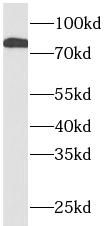Products
STAT1 antibody
Category:
Research Area:
- SPECIFICATIONS
- Product Name
- STAT1 antibody
- Catalogue No.
- FNab09985
- Size
- 100μg
- Form
- liquid
- Purification
- Immunogen affinity purified
- Purity
- ≥95% as determined by SDS-PAGE
- Clonality
- polyclonal
- Isotype
- IgG
- Storage
- PBS with 0.02% sodium azide and 50% glycerol pH 7.3, -20℃ for 12 months(Avoid repeated freeze / thaw cycles.)
Immunogen
- Immunogen
- signal transducer and activator of transcription 1, 91kDa
- Alternative Names
- ISGF 3 antibody, STAT1 antibody, STAT91 antibody
- UniProt ID
- P42224
- Observed MW
- 84 kDa
Application
- Tested Applications
- ELISA, WB, IHC
- Recommended dilution
- WB: 1:500-1:2000; IHC: 1:50-1:500
Validated Images
 Rat liver tissue were subjected to SDS PAGE followed by western blot with FNab09985(STAT1 antibody) at dilution of 1:1000
Rat liver tissue were subjected to SDS PAGE followed by western blot with FNab09985(STAT1 antibody) at dilution of 1:1000
 Immunohistochemistry of paraffin-embedded human breast cancer tissue slide using FNab09985(STAT1 Antibody) at dilution of 1:200
Immunohistochemistry of paraffin-embedded human breast cancer tissue slide using FNab09985(STAT1 Antibody) at dilution of 1:200
- Background
- Signal transducer and transcription activator that mediates cellular responses to interferons(IFNs), cytokine KITLG/SCF and other cytokines and other growth factors. Following type I IFN(IFN-alpha and IFN-beta) binding to cell surface receptors, signaling via protein kinases leads to activation of Jak kinases(TYK2 and JAK1) and to tyrosine phosphorylation of STAT1 and STAT2. The phosphorylated STATs dimerize and associate with ISGF3G/IRF-9 to form a complex termed ISGF3 transcription factor, that enters the nucleus. ISGF3 binds to the IFN stimulated response element(ISRE) to activate the transcription of IFN-stimulated genes(ISG), which drive the cell in an antiviral state. In response to type II IFN(IFN-gamma), STAT1 is tyrosine-and serine-phosphorylated. It then forms a homodimer termed IFN-gamma-activated factor(GAF), migrates into the nucleus and binds to the IFN gamma activated sequence(GAS) to drive the expression of the target genes, inducing a cellular antiviral state. Becomes activated in response to KITLG/SCF and KIT signaling. May mediate cellular responses to activated FGFR1, FGFR2, FGFR3 and FGFR4.



